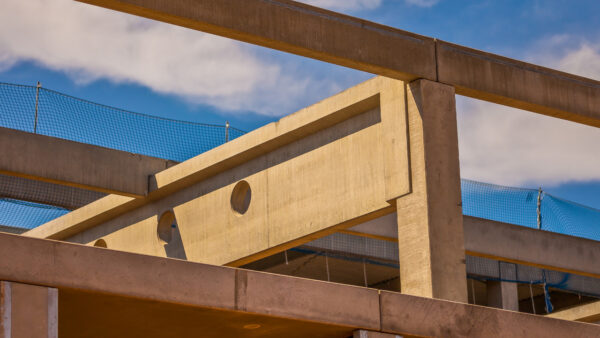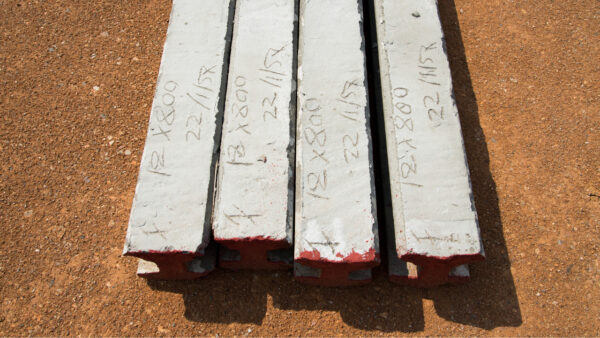The concept of precast concrete dates back to the start of the 20th century when concrete quality control, performance, and economy were deliberated upon by the builders. Some also found it challenging to meet the project requirements in the stipulated time and owing to any delay in the construction work, the overall cost of project got augmented.
Precast concrete construction is one such way of saving construction time by employing ready-made structural concrete elements made in reusable molds at a precast plant. The concrete is not cast on the construction site; rather it is molded off-site into different structural shapes, cured for the required duration and simply transferred to the construction site on trucks.
In addition, in areas where limited space is available for material storage and concrete preparation, precast concrete construction proved to be a viable option.
Table of Contents
What is Precast Concrete?
As the name suggest, precast concrete is a type of concrete that is cast or molded and cured off-site in precast plants or factories and simply the joining of precast members is to be carried on the site.
The precast members can either be non-structural units made from plain cement concrete or prestressed structural members that are pre-tensioned at the plant.
Precast Concrete vs Cast-In-Situ Concrete
The construction industry across the globe is experiencing a rapid switch towards precast concrete construction.
Cast in-situ concrete (also termed as cast in-place concrete) is the conventional way of concreting on the construction site. In this the plastic concrete is molded or poured into the formwork, it gets the desired shape on the site and once hardened, it is cured for the required duration. The structural member cannot be brought into the service condition before the concrete gains its ultimate strength, which usually is a period of 28 days (unless some admixtures are used in the concrete mix).
The process of casting, hardening, and optimum curing oftentimes slows down the construction work and builders have to wait for the concrete to gain its ultimate strength. However, in precast plants, ready-made structural units are available that only need to placed and the structure can be brought to service condition in a lesser duration or time.
In case of precast concrete, the quality can be monitored and controlled easily. This is because of the controlled conditions and measurements in the factory. Contrarily, for cast in-situ concrete, the quality is hard to maintain because it largely depends on the workmanship. Even if the concrete mix is properly prepared, mishandling at the site may lead to poor quality concrete.
The durability, stability, and reliability of precast concrete is more than cast in-situ concrete. This is because the water-to-cement ratio can also be properly adopted and monitored in the former.
The labor required for precast concrete is less than that required for cast in-situ concreting. This is because in the former case, the structural members are only to be connected at site and no formwork or pouring, shuttering, de-shuttering, handling of concrete or curing work is to be done. In addition, in precast construction less skilled labor is required. Therefore, you can get a saving on the labor cost of the project.
The on-site construction is less in case of precast concrete whereas in cast in-situ concreting, all construction activities are essentially to be carried out on the project site.
The formwork and shuttering costs can also be saved in case of precast concrete construction.
In precast concrete factories, high early strength can be achieved by accelerated curing. The curing techniques adopted in a precast plant include steam curing, warm water curing, boiling water curing, or autoclaving. Precast members can immediately be installed once transported to the site. On the other hand, achieving accelerated curing on the construction site in case of cast in-situ concrete is a difficult task and is not worth the effort. Therefore, you will have to resort to waiting for concrete to gain its ultimate strength for the structure to be brought to serviceability condition.
In case of precast concrete, weather condition has no effect on the casting work and no delay can be anticipated so.
Precast concrete does not shrink, distort or move and does not deteriorate when exposed to climatic changes and the construction work is not to be halted even when its raining. Contrarily, in case of rains or any unexpected weather condition, the casting work has to be delayed on site if you go for cast in-situ concrete.
In case of precast concrete, there is increased productivity at the plant and owing to a speedy construction work, early returns on investment can be expected.
Precast concrete generally contains prestressed reinforcement for which lesser quantity of steel is required when compared to that of a reinforced concrete cast in-situ member.
A skilled and technical contractor is required for precast concrete construction whereas any local contractor may be hired for cast in-place concrete construction.
In case of precast concrete, no on-site testing is required because the strength tests are carried out in the factory. On the other hand, for cast in-place concrete, on-site strength testing is extremely important for quality control.
Properties of Precast Concrete
Some of the prominent features that have made precast concrete construction very common in recent years are as follows;
- Precast concrete offers dimensional and geometric accuracy with better quality control.
- The quantity of reinforcement (both conventional and pre-stressing steel) required is reduced.
- Section optimization can be done using precast concrete members and lesser depth members can conveniently bear the same applied load, reducing cost and the structure’s dead weight.
- Precast construction allows design flexibility in terms of the fact that sections can be fabricated by customizing the casting mold. However, in terms of the overall structure, precast construction makes it difficult or rather uneconomical to produce members of varying designs.
- Precast concrete members do not require an added space for material storage.
- This type of construction is speedy and economical for large projects.
- A good finish can be obtained and the structure can be brought to operation or service in a shorter duration.
Applications of Precast Concrete Construction
The applications of precast concrete are vast and in contemporary construction practices, almost every type of construction work can be executed using precast concrete. However, the suitability and economic viability are the primary factors that must be taken into account before making a final decision.
The following are a few applications of precast concrete.
- Precast concrete is used in the construction of bridges where precast deck slab panels, transom beams, floor girders, etc. can directly be transported to the site and installed.
- It can also be used in the construction of office buildings. The walls of the buildings can be made from precast concrete and only the foundation can be cast in-situ, providing a saving in time.
- Precast concrete construction is generally employed for low and medium height structures. It can be used in the construction of hotels and apartment buildings that essentially show a replication of the stories.
- The use of precast, prestressed girders is very beneficial where heavy loads are suspected as in case of flyovers.
- Precast concrete railway sleepers can also be used underneath the railway tracks.
Precast Concrete Elements
1) Precast Concrete Walls
Different types of precast concrete walls are available in market and are manufactured at the precast plant.
Solid walls are normal walls and can easily be made. They may comprise corbels that are either cast on site or on the plant.

Precast concrete walls
Sandwich precast wall comprises two walls sandwiched between an insulating material or insulating board connected using low-conductivity pins. This wall is used for heat insulation purposes. It is mostly used in the construction of industries.
Double wall is another type of precast wall comprising two walls connected by lattice girders. It is mainly used for providing shock-proof properties to the structure.
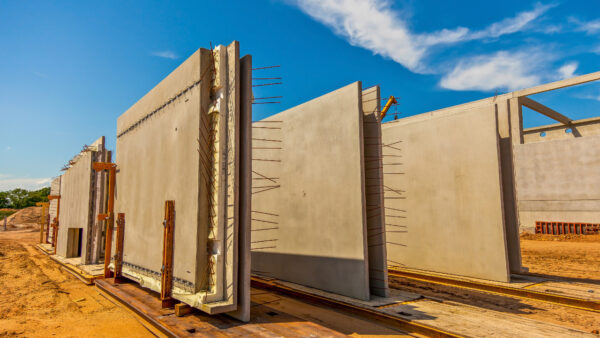
Precast concrete double walls
Precast truss wall is similar to a double wall but it is used in structures subjected to heavy loading such as water treatment plants. It comprises two layers having a triangular framework truss-like structure in between them.
2) Precast Concrete Beams/ Girders

Precast concrete box girders for segmental bridges
Precast concrete beams or girders are available in the market in a variety of shapes such as I shape, T shape, Y shape, etc. and these can even be customized by customizing the mold. These girders are normally prestressed and can effectively be used for long span bridges.
3) Precast Concrete Slab Panels
Precast, prestressed slab panels are available in the market with their thicknesses less than their conventionally-reinforced counterparts. This is because of the pre-stressing steel that optimizes their depth and helps reduce the dead weight.
These panels can be used in buildings having same story dimensions with one story replicating on top of the other.
4) Precast Concrete Columns
Precast concrete columns can be used when in-situ slab is cast and the construction time is desired to be saved because of large number of identical columns. They may be edge columns (normally subjected to uniaxial bending), center columns or internal columns (subjected to no bending theoretically) or corner columns (that usually show biaxial bending behavior).
Precast columns can be rectangular, square, hexagonal, circular, octagonal or any shape depending upon the casting mold uses at the plant.
5) Precast Concrete Foundations
Just like beams and columns, foundation units can also be manufactured off-site in a controlled environment. The bearing capacities of these engineered units is known beforehand and are communicated to the purchaser.
Depending upon the intensity of loading a foundation has to bear, different precast members are available suiting the ground conditions.
6) Precast Concrete Pole Bases
With precast pole bases, you will end up with a huge saving in your time since they can easily be installed in no time. The bases of poles do not have to bear a substantial load, however, based on the pole weight, different sizes of pole bases are available in the market that can easily be fetched and erected on site.
7) Precast Concrete Blocks
Precast concrete blocks are small building units mostly used for masonry construction. Large blocks can be used for constructing retaining walls, curbstones, parking lots, etc.
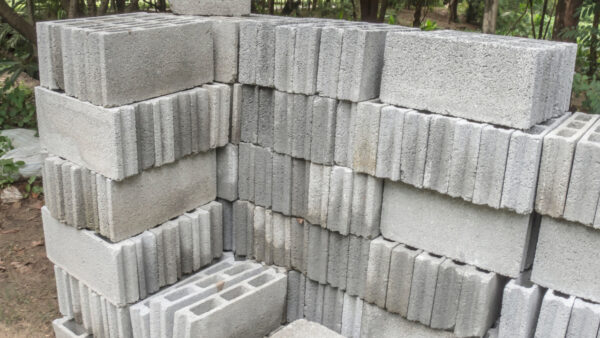
Precast concrete blocks
8) Precast Concrete Stairs
Precast concrete stairs are also available and can easily be installed where a stair tower or individual stair steps are required.

Precast concrete stairs
9) Miscellaneous Products
A number of other precast concrete products are available in the market to ease the construction work. These may include precast concrete fences that can be used at the periphery of houses and other buildings.

Precast concrete fences
Precast concrete drain pipes of varying diameter are also available. Depending upon the amount of discharge a pipe has to carry, the pipe diameter can be selected. Similarly, precast concrete manholes are also available and the opening can be customized to a suited diameter.
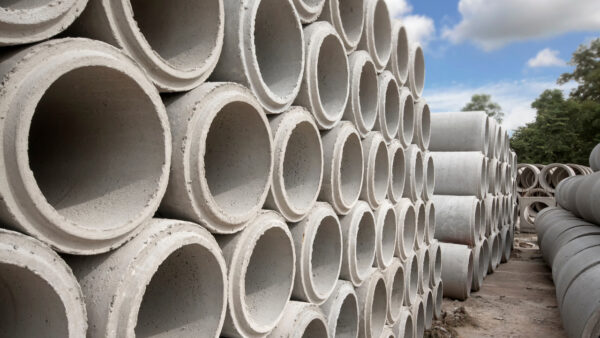
Precast concrete pipes

Precast concrete manholes
Precast irrigation channels have also gained the limelight in recent years. However, these channels are only used for small discharges and save a lot of time required in excavation and filling works for a water channel. Mostly, semi-circular precast channels are used to convey water for irrigation or other purposes.
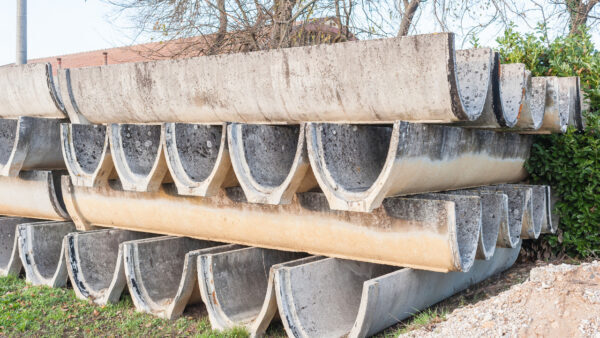
Precast concrete channels
Types of Precast Concrete Construction
Architectural Precast Construction
This type of precast construction is for the appearance of any building or structure. The installed precast members only serve to improve the aesthetics of the structure and play no role in the load-bearing process.
Structural Precast Construction
If load-bearing precast members such as beams, slabs, columns, etc. are installed in a structure or building, the construction is termed as structural precast construction. It is further divided into two sub-categories;
Total Precast
In total precast construction, the entire structure from top to bottom comprises elements made from precast concrete and there in negligible or no cast in-situ activity on the construction site.
Mixed Precast
Mixed precast construction is one in which both precast construction and cast in-situ construction is carried out. Some structural members are precast and are just to be installed on site and some others are molded and cast on-site.
Code Regulations
Precast concrete cannot be randomly used is every type of construction work. Therefore, depending upon where you live and where the project site is located, the codes of practice for precast concrete construction are available.
These regulations serve as construction aids and must be consulted. They provide guidelines on design considerations for precast members, member connectivity at site, types of loads that may act on the member, quality control of members, etc. In addition, the information about proper erection, transportation and handling of precast members on the construction site can also be obtained.
Advantages of Precast Construction
- For large construction project, precast construction leads to a saving in cost, time and also helps enhance the productivity of work and quality of the final structure.
- The mold for precast production can be used repetitively for large number of precast members.
- The wastage of materials in precast construction is negligible.
- Precast structures can be reused, extended and refitted unlike cast in-place concrete members.
- In case of precast construction, negligible or no space is required for material storage on the construction site.
- Material saving can be done in precast construction. Less cement, water and steel quantity is required for the production of precast members.
- Better quality control can be achieved in the form of advanced and engineered mix designs and better vibrations given to compact the concrete in precast plant.
- Labor requirement for precast concrete construction is reduced.
- Precast concrete is more fire-resistant and weather-resistant.
- Precast concrete products are thermally efficient.
- Precast construction provides sound-proof walls.
- This type of construction is environmental-friendly because precast products or elements can be reused and reinstalled.
Disadvantages of Precast Construction
Despite massive advantages of precast concrete construction, its use is not adopted for every type of construction work. This is because very few specialist contractors are available to carry out precast concrete construction. In addition, the developers have a lack of knowledge about precast construction and they may end up committing construction follies that are in no way advantageous for the overall project.
- The lifting and installation of precast members requires heavy machinery. In addition, transportation and shifting costs are also more because of long distance from precast plants.
- Precast concrete construction leaves the structure with greater number of connection joints when compared with onsite casting practices.
- At the joints, proper and careful detailing is to be carried out and asymmetries may lead to inefficient connections between members.
- Precast concrete is less resistant to earthquake and lateral (e.g., wind) forces. Therefore, in areas where seismic loads are dominant, the use of precast concrete members is not suggested.
- The permissible tolerance in precast members is very less (about 3 to 4 mm) in comparison to conventional cast in-situ concrete where 10 mm to 12 mm tolerance is permissible. Therefore, in the former case, if the tolerance exceeds the permissible limit, the elements have to be remolded in a new mold.
- For small projects, precast concrete construction is not economical at all.
- In precast construction, owing to repetition of structural elements, the versatility in design cannot be obtained. This is because it is preferred to use the same mold to cast as many units as possible which leads to design restriction and less flexibility in design.
- The joints of precast elements are to be grouted first and then made water-proof and owing to a large number of joints, this process also becomes costly.
What Points to Consider Before Going for Precast Construction?
The following points should be kept in mind before going for precast concrete method of construction.
- The type and size of the building should be considered and only for large projects, precast construction should be used.
- If the structural members are repetitive (keeping in view their length, geometry, dimensions, and loading), precast construction can be given a green signal.
- If the location of precast plant is far away from the construction site, precast construction will result in huge transportation costs and may not be an economically viable option.
- If the hiring costs of crane and other equipment at site is too high, it is better to not go for precast concrete construction. In addition, if the project site is located in such an area where access through cranes or machinery is difficult, precast concrete should not be used.
- In high seismic zones where structures are vulnerable to earthquakes, the use of precast concrete at site will not provide sufficient earthquake resistance and is therefore no recommended.
Frequently Asked Questions (FAQs)
What factors affect the price of precast concrete products?
The price of a precast member depends on a lot of factors. Firstly, the purpose the element has to serve should be known. This means that you must be aware of whether the precast unit will serve a structural purpose or it is to be installed for architectural or aesthetic reasons.
In the former case, the member is generally reinforced with steel bars and additional prestressing steel is also added to prevent the early onset of flexural cracking and to improve the tensile strength of concrete. If structural precast members are to be used, the member geometry, loading, dimensions, placement and environmental conditions need to be closely assessed.
However, in the latter case, if architectural precast is used, the member’s geometry, location and dimensions are to be taken into account.
What is meant by precast, prestressed member?
The word precast simply means that the member is cast off-site either in a factory or any casting plant. The word prestressing holds significance and this is what makes precast members diverse and reliable in their functioning.
By the term prestressing, it is meant that the member is already stressed to some level by artificial means. In other words, a prestressed member is subjected to compressive stresses by tensioning the steel strands and releasing them.
The release of pretension force exerts a compressive force on the members owing to which compressive stresses develop. These stresses get balanced off once the member is brought to service condition.
However, the advantage of prestressing the member is to eliminate or considerably reduce the tensile stresses in the concrete which otherwise may lead to early onset of flexural cracks, reducing the member’s overall capacity to bear the applied loading.



